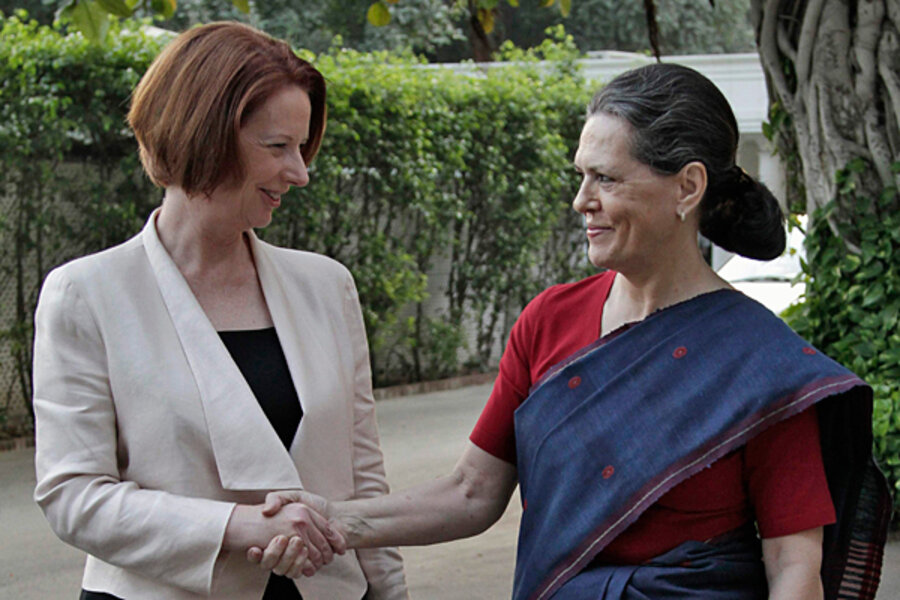Australia marches ahead with India ties - despite a few trip ups
Loading...
| New Delhi
When it comes to bilateral relations, there are a few surefire ways that countries can chalk up some merit points. Australia, dogged by years of mediocre relations with India, a country it desperately craves a deeper relationship with, has put its big guns forward in trying to cement ties.
This week, Australian Prime Minister Julia Gillard has been visiting the Indian capital New Delhi, in what has been billed as her most important foreign visit of the year, and she has used it to make a solid pitch to win over Indian hearts and minds.
Australia's reputation in India was tarnished in 2009 after a spate of violent attacks on Indians studying there left one man dead. Australian officials spent months in damage control, and hope this visit will draw a line under those events.
Ms. Gillard's first step was to announce yesterday that Australia would award its highest civilian honor, the Order of Australia, to India's veteran star cricketer, Sachin Tendulkar. Cricket is played in both countries and is followed with religious fervor in the subcontinent, making Tendulkar one of India’s most popular figures. The decision was questioned at home in Canberra, however it is not the first time Australia has granted the honor to a foreign cricketer.
Next, she launched Oz Fest (www.ozfestindia.com), a $3 million, four-month-long cultural festival that will take Australian artists, musicians, comedians, sportspeople, writers, and more to 18 towns and cities across India, to help convey the notion that Australia is about more than kangaroos and beaches.
Earlier today, Gillard met with her Indian counterpart Prime Minister Manmohan Singh. Their talks included the most talked about aspect of the burgeoning relationship: cooperation on a deal for Australia to sell its uranium to India. Australia has an estimated 23 percent of the world's known uranium reserves, and late last year overturned its long-standing refusal to engage with Delhi, a nonsignatory to the Nuclear Non Proliferation Treaty.
The move altered the tenor of the relationship significantly. India has long wanted Australian uranium to power its nuclear ambitions, as it has decided that nuclear is the best way forward to redress its yawning energy deficiency. In 2008 India signed a deal with the US to buy its nuclear technology; a reliable supply of uranium would complete the chain.
The two countries are also working on a free trade agreement, and they are both pitching hard to attract more trade and investment between them. Currently, bilateral trade stands at around $20 billion, and Gillard wants to double that. Australia is rich in natural resources such as LPG and coal, and the country's education and technology industries are also of great interest to the Indians.
The Australian leader also announced a desire for greater military cooperation for the Indian Ocean, which lies between the two countries.
It all points to India's growing importance on the world stage. Australia, a middling power that recently elevated to the world's 12th largest economy, in the past focused primarily on China, but is now looking to diversify with another strong regional relationship. Now, it ranks a relationship with New Delhi as one of its top bilateral priorities, and good economic ties as vital to its future prosperity.
The trip could not have come at a better time for Gillard, who is riding a crest of newfound global popularity as a feminist icon, after making a speech in parliament in which she delivered a stinging smackdown to Australia’s opposition leader Tony Abbott in parliament last week. The video of the speech, in which she brands him as sexist and a misogynist, went viral around the world, prompting the Macquarie Dictionary to update their definition of the word ‘misogyny’, and had even The New Yorker hailing her bravura. The video was played on Indian news channels, helping to raise her profile ahead of her trip.
But just in case Gillard was feeling a bit too superhuman, fate stepped in during today’s visit to the Gandhi Memorial and tripped her up. Spectacularly.







